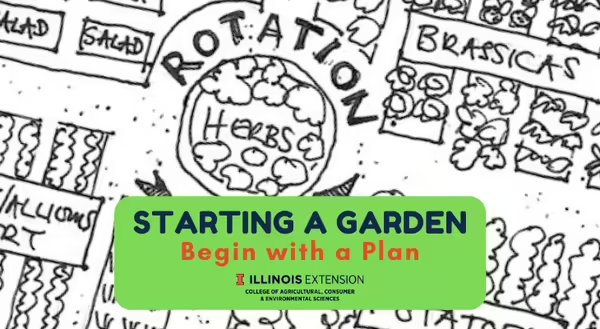
Starting a Garden: Begin with a Plan
The key to a successful and productive garden is a plan; it saves time and makes the garden easier to care for. By starting with a plan, you will be ready to get to work once planting time is here. So let’s get started!
Site Selection
Location, location, location is what they say when buying a house, and that also applies when planting a garden; the success of a garden is largely dependent on its location. When determining a garden location, it is important to choose an area exposed to full sun as most vegetable crops require a minimum of 6 hours of daily sunlight to grow. Be sure to avoid trees and shrubs that might shade your garden area. It is important to choose a location with loose, rich, level, and well-drained soil. Do not use an area where water stands, or the soil stays wet; vegetables do not grow well in poorly drained areas. Ideally, water would be supplied through timely rain events; however, we have experienced dry years, so it is wise to have a backup water source near your garden for supplemental watering. I would also suggest taking a soil sample from your garden to know if any additional fertilizer is needed or pH needs adjusted.
Crop Selection
Now for the fun part; deciding what to plant! What you plant is dependent on the size of your garden. If you only have room for a small garden, you may not want to plant watermelon or pumpkins as they take up too much room; unless all you want is watermelon or pumpkins. There are some alternatives for vine crops in a small space; these plants can be trellised on fence or other support structures to take up less space. Radishes, turnips, and beets require less space and yield quickly; whereas, tomatoes, bush green beans, squash, and peppers require more space but produce for a longer period. Ultimately, you should plant vegetables that you and your family like to eat.
Planting Arrangement
Arrange vegetables in a way that utilizes space and light. To avoid shading plants, tall vegetables such as corn and tomatoes should be planted on the north side of the garden. Also, group vegetables according to their maturity; this makes it easier to remove quick growing vegetables, and for the space to used for later plantings. For perennial crops such as asparagus or rhubarb, these should be planted toward the side of your garden since they will remain in the same location each year. For annual crops, do not grow the same vegetable or vegetables in the same family (ex. Solanaceae family consists of eggplants, bell peppers, potatoes, and tomatoes) in the same location more than once in every three years. By rotating crops each year, it helps to control diseases that survive in the soil over winter.
Now It’s Time to Plan!
Once you have your garden location and vegetables selected, you can now design your garden. Some things to consider when you are sketching out your garden include row length, row orientation (E/W or N/S), row spacing between rows, spacing between plants within the row, and planting dates. All of this information can be found on the seed packet.
With a plan in place, your garden is destined to be a success! Feel free to contact your local Extension office at go.illinois.edu/ExtensionOffice for any questions that might turnip!
- Chris Enroth- Serving Henderson, Knox, McDonough, Warren Counties
- Ken Johnson- Serving Calhoun, Cass, Greene, Morgan, and Scott Counties
- Katie Parker- Serving Adams, Brown, Hancock, Pike, and Schuyler Counties
Good Growing tip of the week: Some plants such as tomatoes, peppers, broccoli, lettuce, and cabbage prefer to be transplanted into the garden. These plants can be started in your home or purchased from a store. When growing or buying transplants, avoid plants that are tall, yellow, and spindly.
MEET THE AUTHOR
Katie Parker is a Local Foods and Small Farms Educator with University of Illinois Extension, serving Adams, Brown, Hancock, Pike, and Schuyler counties. Katie provides programming with an emphasis on row crop production, soil fertility, composting, vegetable production, and ornamental horticulture.
Signup for our emails! Want to get notified when new Good Growing posts are available? SIGN ME UP